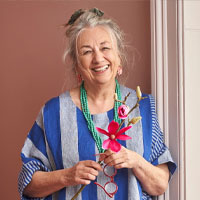What is Bauhaus style? Experts explain the key principles of this iconic look
From abstract art to standout furniture design, we investigate the ethos behind Bauhaus style

Founded by architect Walter Gropius in Germany back in 1919, the Bauhaus movement's objective was to unite art and industry whilst focusing on functionality, style, and design features like geometrics and bold color. He formed the Bauhaus school which went on to be the most influential modernist art school of the 20th Century.
The aim was to give soul to functional design by incorporating fine art, and out of this came furniture designs from the likes of Ludwig Mies van den Rohe and Marcel Breuer, paintings from Paul Klee and Wassily Kandinsky, graphic design from Herbert Bayer and architecture like the Bauhaus building in Dessau, Germany.
This interior style has been hugely influential, it still inspires design today,in fact, like many vintage and retro styles it's having a bit of a resurgence in 2024.
Bauhaus style: The Details
Bauhaus style is bold and beautiful with an emphasis on strong design that's functional, which at the time wasn't something that was being combined together.
'Its minimal design approach uses shapes and colors, primarily for function instead of decoration. It tends to have clean lines, bold, simple colors, and uses industrial materials,' say Barrett Oswald and Mary Long, founders of Barrett Oswald Designs.
We look into the key design features that make up this iconic look that is the epitome of minimalism and how it influences today.

Barrett has always had a passion for style and design. Her love of interior design has been a natural progression – from a teenager who mixed toile wallpaper and band posters in her bedroom, to a graduate of the Fashion Institute in NYC, and eventually to the stylist of a commercial, oceanfront condominium in Florida. Prior to joining Barrett Oswald Designs, MaryBeth served as manager of legal recruiting in New York, her introduction to interior design came when Barrett helped her create a calm, clean and contemporary home, she is the director of business relations at Barrett Oswald Designs.
How Bauhaus style grew

Encompassing every design feature from architecture, furniture, art, textiles, and graphic design, the Bauhaus style grew once the first school was built. It existed in three German cities, Weimar, from 1919-1925, Dessau, from 1925-1932 and Berlin, from 1932-1933. Each was run by three different architects who became directors, Walter Gropius, Hannes Meyer, and Ludwig Mies van de Rohe.
Design expertise in your inbox – from inspiring decorating ideas and beautiful celebrity homes to practical gardening advice and shopping round-ups.
Championing geometric abstract styles, the movement grew with artists like Klee and Kandinsky teaching classes, with other artists focussing on typography, photography and sculpture.
Iconic Bauhaus design features

Strong shapes, linear shapes, and iconic motifs make Bauhaus style immediately recognizable. Philippe Desart, owner and managing director of Arte International explains how it translates today:
'Its iconic use of often abstract, geometric, and angular shapes translate well as wallcoverings, whether as a print or woven and textured interpretations, where these intriguing patterns deliver depth and dimension to a room.
Equally, when presented in a room with less pattern and a limited color palette, the linear detailing of these motifs create a strong framework and focal point, bringing interest and drama and therefore are also a brilliant design choice for a minimalist interior.'
'To achieve this look in your own home, start by discarding anything non-essential to the space. Once you have a paired-down room, look to keep or add furniture pieces that align with the Bauhaus era like a Wassily or Barcelona-shaped chair. On a smaller scale, you can add Bauhaus art or a chess set as a nod to this unique style,' say Barrett Oswald and MaryBeth Long.

Company owner and managing director, Philippe Desart heads up Arte, a third-generation family business, rooted in creativity, craftsmanship, ingenuity and inventiveness, born out of a vision for beauty. Arte strives to create exquisite, innovative, and eclectic wallcoverings for sophisticated global interiors. Arte’s designs are more than wallpaper, they are exceptional, ground-breaking and truly original wall finishes.
Bauhaus style and color

If you love color then the Bauhaus style is for you, bright primary shades are dominant but you can use secondary colors too.
'More than most design schools, Bauhaus is a philosophy; so as well as using notable design elements in your home – primary colors, threads of color leading from one room to another, rounded shapes – let the principles of Bauhaus guide your decisions,' advises paint and color expert, Annie Sloan, CBE.
Use color blocks to create impact and use them around the house, linking rooms. 'A statement shade on walls painted with rounded shapes or curved lines which is repeated throughout an entire home is a key Bauhaus feature. They would have large blocks of color in one room, then repeat that on banisters on stairways leading to other rooms where that color might be used as an accent shade, or spilled all over the floor, or wink at you from a piece of furniture,' adds Annie.

Annie Sloan, CBE, invented her revolutionary furniture paint, Chalk Paint™, in 1990. She is widely considered as one of the world's leading authorities in paint, color and style.
How to introduce Bauhaus style

The Bauhaus style can be used in any space of the home, all you need to do is follow the key aspects – angular lines, bold color, and minimalist furniture.
Jamie Watkins, co-founder of Divine Savages says, 'A bathroom is typically a place for functional design and sleek lines, the epitome of Bauhaus style, so we absolutely love this one with its yellow grouting and striking sink – a true homage to Bauhaus sensibilities. Our modern twist on this iconic style sees simplicity and abstraction meet an aviary explosion with our Geometric Aviary wallpaper, a mix of black and white geometrics and brightly colored birds, it infuses the space with the timeless essence of Bauhaus but with a contemporary flair.'
It's also about what you leave out, so keep clutter to a minimum and only use items that have a use, and of course fit the functionality of Bauhaus style. Also, think outside of the box, we particularly love the use of yellow grout, it really does change the look of this bathroom.

Divine Savages specialises in creating exquisitely crafted wallpapers, fabrics, accessories and limited edition art prints for the brave and bold. It was founded by husbands Jamie Watkins and Tom Kennedy in 2017. Taking inspiration from history, culture, fashion and the natural world to create an eclectic mix of influences, Divine Savages has, to date, created myriad designs whose personalities come across just as much in their names as they do visually.
'The Bauhaus style continues to be a huge source of inspiration and recognized for many as the birth of modern design,' says Philippe Desart.
If you love minimalism then Bauhaus style is for you, start small and incorporate some of the principles in one room first, then build it up. It's about teaming the elements with your personality and creating a welcoming home that you love.

Sophie has been an interior stylist and journalist for over 20 years and has worked for many of the main interior magazines during that time, both in-house and as a freelancer. On the side, as well as being the News Editor for indie magazine, 91, she trained to be a florist in 2019 and launched Flowers Inside My Head where she curates beautiful flowers for modern weddings and events. For Homes & Gardens, she writes features about interior design – and is known for having an eye for a beautiful room.